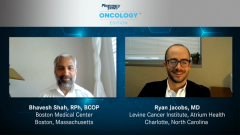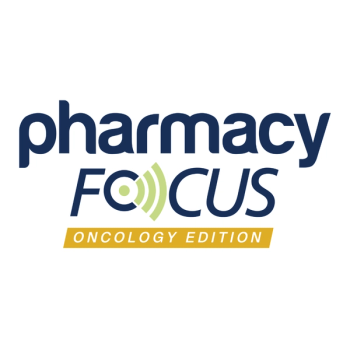
Role of Chemotherapy in Frontline CLL Treatment
Dr Ryan Jacobs evaluates the use of chemotherapy options for first-line treatment of CLL.
Episodes in this series

Bhavesh Shah, RPh, BCOP: In regard to the mutation analysis, does that help you drive in terms of how you are going to initially choose a patient’s regimen if a patient has a 17p deletion or the other mutations that they may have?
Ryan Jacobs, MD: Personally, in my practice, for reasons we’ll probably cover shortly, I’m not actually using chemotherapy to treat CLL [chronic lymphocytic leukemia] really anymore. I’m using our targeted agents for a number of reasons. What’s wonderful is our targeted agents in particular have benefited those patients that were doing the worst with chemotherapy. Those patients are the ones that are actually benefiting the most from having these novel, small molecule inhibitor options. One might argue, “Well, if you’re not going to use chemotherapy, do you really need this prognostic workup?” As the data has shown, with the exception of the chromosome 17 aberration patients, the formerly felt to be poor prognostic subgroups of patients, like having a deletion 11q or having unmutated IgHV [immunoglobulin heavy chain gene] status that were doing historically poorly with chemotherapy, these patients are doing just as well as patients without those abnormalities with our novel therapies. For example, I think the group that’s probably benefited the most from small-molecule inhibitor treatments has been the IgHV unmutated group because that represents about 45% of our patients that we are wanting to treat in the frontline setting. Those patients, historically, were doing pretty poorly with chemotherapy relative to the mutated group. I do think even if you’re not going to use chemotherapy, there is utility for the prognostic workup. Certainly, if chemotherapy is something you’re considering, you have to do the prognostic workup so that you’re not making the wrong treatment decision for those high-risk patients. But even if you are settled on using a small molecule inhibitor option, I think the patient group that still requires special consideration are those patients with chromosome 17 aberrations. That’s going to be a deletion 17p on FISH [fluorescence in situ hybridization] and/or a TP53 [tumor protein p53] mutation. Specifically, why I highlight that group, is because when we talk about our frontline treatment options, the consideration between indefinite BTK [Bruton tyrosine kinase] inhibition versus time defined BCL2 [B-cell lymphoma 2]-based inhibitor therapy, it looks like, on albeit small subgroup analysis, these chromosome 17p deleted patients were progressing significantly quicker with the time-defined option of venetoclax [Venclexta] for 1 year based on the CLL14 [clinical trial] approach. Probably PFS [progression-free survival] is a bit less than 2 years, whereas we have a decent amount of BTK inhibitor-indefinite treatment data with our frontline 17p deleted patients, particularly on the ibrutinib [Imbruvica] side that would suggest you’re getting over 50 months of PFS with indefinite BTK inhibition. That subgroup still bears some, I think, unique consideration, and you can use the prognostic workup to help supplement your decision. Thankfully, that high-risk subgroup is a small fraction of the overall pie, probably only about 10% of the frontline treated patients have a deletion at chromosome 17p. Then, for the rest of the 90%, we don’t necessarily have a whole lot of data to guide us between BTK and BCL2 necessarily. That’s where you really have to talk to the patient and evaluate a number of things to try to come up with the best treatment option for that patient.
Bhavesh Shah, RPh, BCOP: That’s a great perspective. I feel like the NCCN [National Comprehensive Cancer Network] guidelines don’t do justice at kind of providing that insight that we know about the fixed duration and these 17p deletion patients. I think that’s really important for a lot of folks to be aware of, because there is that appeal of having that fixed duration therapy of 1 year. There’s 4-year survival data that shows 85% of patients have this benefit, but I think really kind of outlining that those 10% of patients may not benefit with that treatment strategy. That’s a really great perspective also to understand that the whole workup, in terms of the FISH analysis and the sequencing that we’re doing, is really kind of identifying this niche group and then also, obviously, it doesn’t make sense if you’re not using chemotherapy. Then, there is a prognostic aspect that you’re actually really looking for, so that’s really great to understand. It’s amazing to have agents like BTK inhibitors, which you don’t have to worry about that. I think from that, I feel like you’re probably going to say that is my go-to option for almost every single CLL patient, no matter what the deletion status is, no matter what the DNA sequencing shows. Is that my correct assumption?
Ryan Jacobs, MD: That my go-to is going to be BTK inhibition frontline? No, actually. Again, when you push away that 10% of patients that have their chromosome 17 aberration, looking at the rest of the group, I certainly am using a significant amount of frontline venetoclax. I think the easiest way to break down that discussion between BCL2 inhibition versus BTK inhibition, which we feel like are equivalent treatment options for those 90% of patients that don’t have that chromosome 17 aberration, if the patient is prioritizing convenience, minimal disruption to their lifestyle, and a low touch approach—I find this as patients trend older, more comorbid, maybe they’re on several medicines already that they take daily—adding an additional oral medicine as a single agent to their schedule and maybe just coming to check in with the oncologist, maybe even virtually once every month or so, and that lengthens out pretty quickly. Clearly, that’s the indefinite BTK inhibitor route. Of course, there’s certain medical comorbidities that might sway you away, but I’m just trying to be relatively simplistic here, and we can delve into those special considerations later. Certainly, the patient that doesn’t necessarily mind some front-loaded work in terms of shuttling back and forth to the infusion center, getting a lot of lab work, and maybe some extra IV fluids with the idea that after a year they get to stop treatment, then for that patient I’m going to be thinking about venetoclax-based therapy based on that CLL14 approach where you do the obinituzumab [Gazyva] lead-in and then give the venetoclax for a year. As for the long-term data for both of the 2 BTK inhibitor options that we have FDA [Food and Drug Administration] approved right now for CLL—ibrutinib and acalabrutinib [Calquence]—we actually don’t have a median progression-free survival. The curves are quite flat, all the way out to 7 years plus at follow-up. We have not hit a median. Then the data that we have at this point on the CLL14-based approach is at 4 years of follow-up, and after stopping therapy for 3 years, 72% of patients are still free of progression. Those survival curves seem pretty similar to each other, so we do feel like they are equivalent options. Then, of course, interestingly, if you’re talking about venetoclax in patients that have had multiple years of benefit off therapy, you can then consider re-treatment with venetoclax if they were to progress down the road, and there’s some early data to suggest at least 50% or more of patients would respond to re-treatment and really extend the PFS in that manner. Both are good options. Certainly, when you’re talking about clinical trials on top of it, it makes for quite a complicated discussion in many circumstances.
Bhavesh Shah, RPh, BCOP: Absolutely. I think you are kind of swaying me towards more of the venetoclax/obinituzumab option.
Transcript Edited for Clarity
Newsletter
Stay informed on drug updates, treatment guidelines, and pharmacy practice trends—subscribe to Pharmacy Times for weekly clinical insights.




